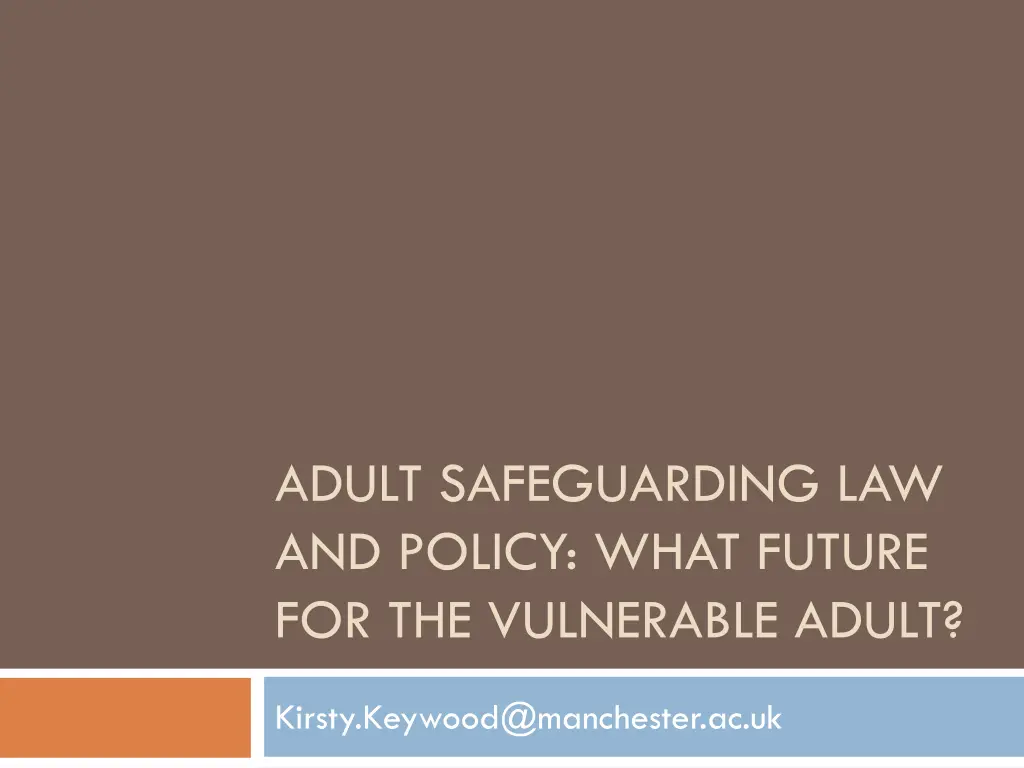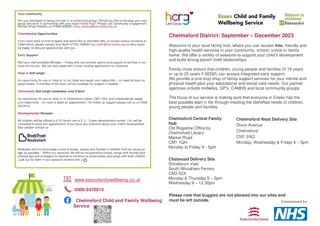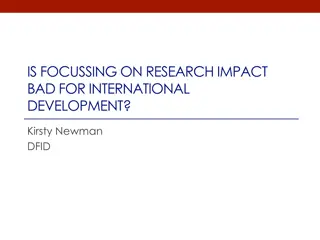
Safeguarding Law and Policy for Vulnerable Adults: Future Perspectives
Exploring the dynamics of vulnerability in safeguarding law and policy for vulnerable adults, addressing common experiences, structural factors, ethical responses, and the relationship between care needs and vulnerability. Analyzing scenarios where safeguarding may not apply and the implications of mental health and capacity limitations in providing care.
Download Presentation

Please find below an Image/Link to download the presentation.
The content on the website is provided AS IS for your information and personal use only. It may not be sold, licensed, or shared on other websites without obtaining consent from the author. If you encounter any issues during the download, it is possible that the publisher has removed the file from their server.
You are allowed to download the files provided on this website for personal or commercial use, subject to the condition that they are used lawfully. All files are the property of their respective owners.
The content on the website is provided AS IS for your information and personal use only. It may not be sold, licensed, or shared on other websites without obtaining consent from the author.
E N D
Presentation Transcript
ADULT SAFEGUARDING LAW AND POLICY: WHAT FUTURE FOR THE VULNERABLE ADULT? Kirsty.Keywood@manchester.ac.uk
Why vulnerability? Commonality of experience; universal yet also particular. Expansive and dynamic accounts for structural factors that render us vulnerable: poverty; environmental catastrophe, inequality etc E.g. Brown (1999): in a dynamic force field at the meeting point of unchecked male power, poorly trained and ill-supported staff, conflicts between a profits and care ethic and weak arms length regulation. Prompts a different set of responses (fostering resilience) , e.g. affirmative rather than negative political responses. A vehicle for other ethical principles or A new ethical imperative?
Safeguarding Policy No Secrets - Vulnerable adult: Aged 18 who is or may be eligible for community care services and who is or may be unable to take care of him or herself, or unable to protect him or herself against significant harm or exploitation. No-one shall be subject to inhuman or degrading treatment (Art 3 ECHR) The more vulnerable the victim, the more likely it is that the threshold of minimum severity will be met. The assessment of the minimum threshold is relative and depends on all the circumstances of the case including the duration of treatment, the physical or mental effects and the sex, age and state of health of the victim = Price v UK (1998).
Social models of disability and care needs Vulnerability associated with a personal need for care Is the person suffering harm or exploitation? Does the person suffering or causing harm/exploitation meet the NHS and Community Care Act (1990) eligibility criteria? No Secrets only 18% of safeguarding referrals concerned individuals with no, or unknown, support needs (NHS, 2016). But is there something about having a need for community care support that renders a person particularly, or additionally vulnerable?
Safeguarding not for all - Adult A Luton ASB 2011 He was perceived as having no physical or health impairments that warranted community care intervention. His rejection of support was treated as an autonomous expression of self-sufficiency rather than the realities of chronic exhaustion, unemployment, depression, hunger, drugs, exploitation, street prostitution, street crime, and chronic health problems.
Limits of mental health and capacity law: Ann SAB Sheffield Dystonia; was a wheelchair user; range of physical support needs Uncooperative with carers; demanding of particular staff Self-neglecting if things weren t done her way Services ultimately withdrawn because her refusal to accept the care plan was unreasonable. Ann refused to be moved from her broken and soiled wheelchair but allowed partial assistance from her GP and a nurse. When Ann died her Body Mass Index was below 12. A BMI of 13 is considered the point at which risk of death from starvation is significant. ... her behaviour conformed more to text book accounts of a personality disorder but no diagnosis of mental disorder and no assessments of capacity.
Will anything change? Adult Support and Protection Act 2007 s.3 Care Act 2014 s.42(1) P has needs for care and support (whether or not the authority is meeting any of those needs), a) Adults at risk are adults who are unable to safeguard their own well-being, property, rights or other interests, a) is experiencing, or is at risk of, abuse or neglect, and b) are at risk of harm, and b) as a result of those needs is unable to protect himself or herself against the abuse or neglect or the risk of it. c) because they are affected by disability, mental disorder, illness or physical or mental infirmity, are more vulnerable to being harmed than adults who are not so affected. c)
Is this the end of the vulnerable adult? Emergence in the inherent jurisdiction Potential for UNCRPD compliance unlike threshold concepts of mental disorder (MHA) and mental incapacity (MCA). Potential for inclusion in regulatory architecture (e.g. inspections; approvals; audit); service commissioning.


